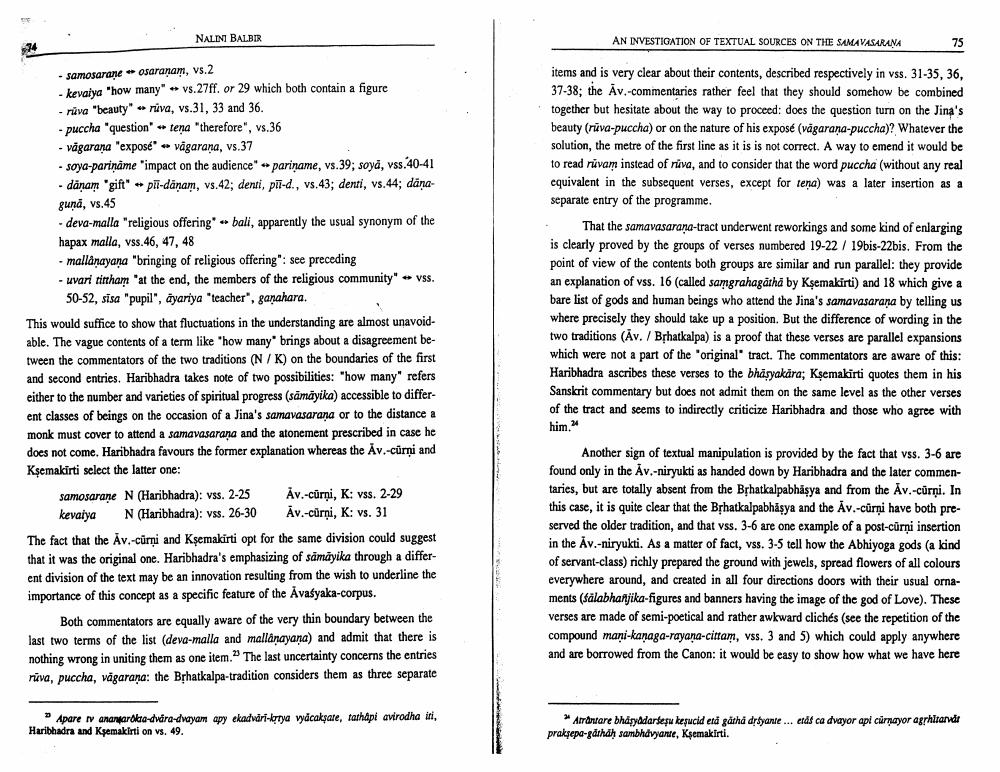Book Title: An Investigation Of Textual Sources On Samavasarana Author(s): Nalini Balbir Publisher: Nalini Balbir View full book textPage 5
________________ NALINI BALBIR AN INVESTIGATION OF TEXTUAL SOURCES ON THE SAMAVASARANA 75 items and is very clear about their contents, described respectively in vss. 31-35, 36, 37-38; the Av. commentaries rather feel that they should somehow be combined together but hesitate about the way to proceed: does the question turn on the Jina's beauty (riva-puccha) or on the nature of his exposé (vägaran-puccha)? Whatever the solution, the metre of the first line as it is is not correct. A way to emend it would be to read ruvam instead of riva, and to consider that the word puccha (without any real equivalent in the subsequent verses, except for tena) was a later insertion as a separate entry of the programme. - Samosarane osaranam, vs.2 -kevaiya "how many" vs.27ff. or 29 which both contain a figure - riva "beauty" - růva, vs.31, 33 and 36. - puccha "question' tena "therefore", vs.36 - vägarana "exposé -> vāgarana, vs.37 soya-pariname "impact on the audience" pariname, vs.39; soya, vss40-41 dānam "gift" - pii-dānam, vs.42; denti, pi-d., vs.43; denti, vs.44; dänagunā, vs.45 deva-malla "religious offering-bali, apparently the usual synonym of the hapax malla, vs. 46, 47, 48 - mallånayaņa "bringing of religious offering": see preceding - uvari tirtham "at the end, the members of the religious community" - vs. 50-52, sīsa "pupil", āyariya "teacher", ganahara. This would suffice to show that fluctuations in the understanding are almost unavoidable. The vague contents of a term like "how many brings about a disagreement between the commentators of the two traditions (N/K) on the boundaries of the first and second entries. Haribhadra takes note of two possibilities: "how many" refers either to the number and varieties of spiritual progress (sāmāyika) accessible to different classes of beings on the occasion of a Jina's samavasarana or to the distance a monk must cover to attend a samavasarana and the atonement prescribed in case he does not come. Haribhadra favours the former explanation whereas the Av.-cúrni and Kşemakirti select the latter one: samosarane N (Haribhadra): vss. 2-25 Av.-cūrņi, K: vs. 2-29 kevalya N (Haribhadra): vs. 26-30 Av.-cúrni, K: vs. 31 The fact that the Av.-сürmi and Kșemakirti opt for the same division could suggest that it was the original one. Haribhadra's emphasizing of sämáyika through a different division of the text may be an innovation resulting from the wish to underline the importance of this concept as a specific feature of the Avasyaka-corpus. Both commentators are equally aware of the very thin boundary between the last two terms of the list (deva-malla and mallanayana) and admit that there is nothing wrong in uniting them as one item. The last uncertainty concerns the entries riva, puccha, vägarana: the Brhatkalpa-tradition considers them as three separate That the samavasarana-tract underwent reworkings and some kind of enlarging is clearly proved by the groups of verses numbered 19-22 / 19bis-22bis. From the point of view of the contents both groups are similar and run parallel: they provide an explanation of vss. 16 (called samgrahagātha by Ksemakirti) and 18 which give a bare list of gods and human beings who attend the Jina's samavasarana by telling us where precisely they should take up a position. But the difference of wording in the two traditions (Av. / Bịhatkalpa) is a proof that these verses are parallel expansions which were not a part of the original tract. The commentators are aware of this: Haribhadra ascribes these verses to the bhäsyakära; Kșemakirti quotes them in his Sanskrit commentary but does not admit them on the same level as the other verses of the tract and seems to indirectly criticize Haribhadra and those who agree with him. Another sign of textual manipulation is provided by the fact that vss. 3-6 are found only in the Av.-niryukti as handed down by Haribhadra and the later commentaries, but are totally absent from the Brhatkalpabháşya and from the Av.-cürņi. In this case, it is quite clear that the Brhatkalpabhāşya and the Av.-cürni have both preserved the older tradition, and that vs. 3-6 are one example of a post-cürni insertion in the Av.-niryukti. As a matter of fact, vs. 3-5 tell how the Abhiyoga gods (a kind of servant-class) richly prepared the ground with jewels, spread flowers of all colours everywhere around, and created in all four directions doors with their usual ornaments (Salabhanjika-figures and banners having the image of the god of Love). These verses are made of semi-poetical and rather awkward clichés (see the repetition of the compound mani-kanaga-rayana-cittam, vs. 3 and 5) which could apply anywhere and are borrowed from the Canon: it would be easy to show how what we have here Apare v anaryar okta-dvdra-dwayam apy ekadvāri-korya vyacaksate, tathapi avirodha iti, Haribhadra and Kyemakirti on vs. 49. ** Aträntare bhásyadarsegu kesucid eta gåtha drfyante ... etds ca dvayor api cürnayor agrhitar de praksepa-gáthaḥ sambhdvyane, Ksemakirti.Page Navigation
1 ... 3 4 5 6 7 8 9 10 11 12 13 14 15 16 17 18 19 20
